The purpose of this thread is actually simply to prove by the absurd, in using another city example, that the theory about the South East of England being London metro area is a non sense. So I'll start in giving my arguments on why Paris metro area is at 16 million people... and those are exactly the same which are advocated for a London metro area of 18 million people. Afterwards, I'll explain why this reasoning is wrong.
So, let's start the game. Paris metro area is indeed at 16 million people for the simple reason that this figure is the result of grouping several satellite cities of Paris which are linked to the main core by a large proportion of commuters (40%). Indeed, those satellite cities are all sharing commuters with Paris, and the best way to prove it is to look at an official map published by the INSEE, the body issuing official statistics in France :

As you can see in that map, in dark orange are pictured the urban cores, in light orange are pictured the periurban belt centered on one urban core, and in yellow are pictured the periurban belt shared by at least two urban cores. If we group them altogether, we obtain what is in the red circle : a region sharing commuters at a very high level (more than 40% commuters). As this region is linked by the 40% commuter criteria, it represents Paris metropolitan area : An area of 16.7 million people.
Now the arguments have been given, but there's a flaw among them making the whole reasoning irrelevant. What is that flaw ? That flaw is simply that the purpose of metropolitan areas is not to group together various cities of hundreds of thousands people, the purpose of metropolitan areas is to determine a periurban belt around an urban core.
A periurban belt is made of sparsely peopled areas which are not part of the urban area, but which have enough commuters to be directly associate with it. To give you an example, that's exactly the reason why San Francisco and San José are not part of the same metropolitan area. Indeed there are certainly more than 40% commuters between both places, but San José is an enough big and densely populated area to be considered as being on its own an urban core.
In my Paris example, all the areas in dark oranges are enough large urban cores to have their own metropolitan areas, and the fact they are 40% of commuters between those cores or not is completely irrelevant to the question whether or not they belong to the same metro area.
As such, the map above do not picture Paris metro area, but it actually also pictures the metro areas of Creil, Senlis, Provins, Nemours, Chartres, Dreux, Vernon, Evreux, Rouen and all the other satellite cities (and not satellite periurban areas) around Paris.
As a result, Paris metropolitan area is indeed of 11.5 million people, just like London metropolitan area is between 12 and 13 million people.>

No comments:
Post a Comment